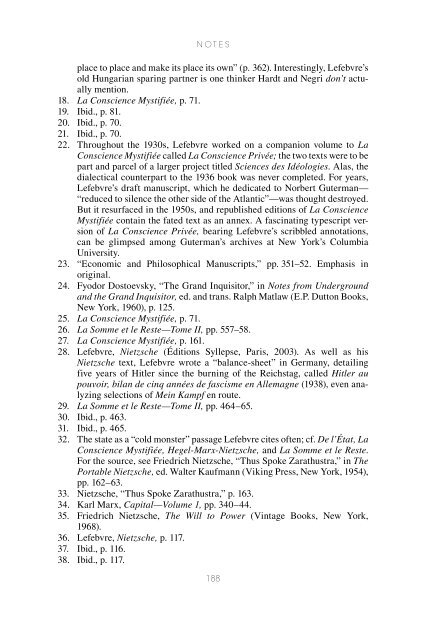Henri Lefebvre: A Critical Introduction - autonomous learning
Henri Lefebvre: A Critical Introduction - autonomous learning
Henri Lefebvre: A Critical Introduction - autonomous learning
Create successful ePaper yourself
Turn your PDF publications into a flip-book with our unique Google optimized e-Paper software.
n o t e s<br />
place to place and make its place its own” (p. 362). Interestingly, <strong>Lefebvre</strong>’s<br />
old Hungarian sparing partner is one thinker Hardt and Negri don’t actually<br />
mention.<br />
18. La Conscience Mystifiée, p. 71.<br />
19. Ibid., p. 81.<br />
20. Ibid., p. 70.<br />
21. Ibid., p. 70.<br />
22. Throughout the 1930s, <strong>Lefebvre</strong> worked on a companion volume to La<br />
Conscience Mystifiée called La Conscience Privée; the two texts were to be<br />
part and parcel of a larger project titled Sciences des Idéologies. Alas, the<br />
dialectical counterpart to the 1936 book was never completed. For years,<br />
<strong>Lefebvre</strong>’s draft manuscript, which he dedicated to Norbert Guterman—<br />
“reduced to silence the other side of the Atlantic”—was thought destroyed.<br />
But it resurfaced in the 1950s, and republished editions of La Conscience<br />
Mystifiée contain the fated text as an annex. A fascinating typescript version<br />
of La Conscience Privée, bearing <strong>Lefebvre</strong>’s scribbled annotations,<br />
can be glimpsed among Guterman’s archives at New York’s Columbia<br />
University.<br />
23. “Economic and Philosophical Manuscripts,” pp. 351–52. Emphasis in<br />
original.<br />
24. Fyodor Dostoevsky, “The Grand Inquisitor,” in Notes from Underground<br />
and the Grand Inquisitor, ed. and trans. Ralph Matlaw (E.P. Dutton Books,<br />
New York, 1960), p. 125.<br />
25. La Conscience Mystifiée, p. 71.<br />
26. La Somme et le Reste—Tome II, pp. 557–58.<br />
27. La Conscience Mystifiée, p. 161.<br />
28. <strong>Lefebvre</strong>, Nietzsche (Éditions Syllepse, Paris, 2003). As well as his<br />
Nietzsche text, <strong>Lefebvre</strong> wrote a “balance-sheet” in Germany, detailing<br />
five years of Hitler since the burning of the Reichstag, called Hitler au<br />
pouvoir, bilan de cinq années de fascisme en Allemagne (1938), even analyzing<br />
selections of Mein Kampf en route.<br />
29. La Somme et le Reste—Tome II, pp. 464–65.<br />
30. Ibid., p. 463.<br />
31. Ibid., p. 465.<br />
32. The state as a “cold monster” passage <strong>Lefebvre</strong> cites often; cf. De l’État, La<br />
Conscience Mystifiée, Hegel-Marx-Nietzsche, and La Somme et le Reste.<br />
For the source, see Friedrich Nietzsche, “Thus Spoke Zarathustra,” in The<br />
Portable Nietzsche, ed. Walter Kaufmann (Viking Press, New York, 1954),<br />
pp. 162–63.<br />
33. Nietzsche, “Thus Spoke Zarathustra,” p. 163.<br />
34. Karl Marx, Capital—Volume 1, pp. 340–44.<br />
35. Friedrich Nietzsche, The Will to Power (Vintage Books, New York,<br />
1968).<br />
36. <strong>Lefebvre</strong>, Nietzsche, p. 117.<br />
37. Ibid., p. 116.<br />
38. Ibid., p. 117.<br />
1
















